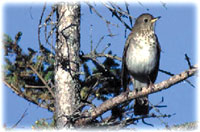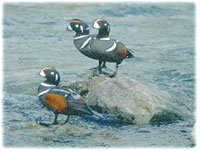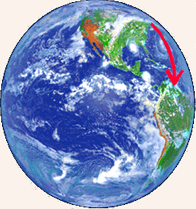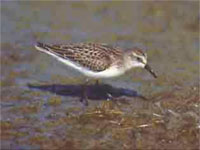
Natural Resources Canada > Earth Sciences Sector > Priorities > Climate Change Impacts and Adaptation > Climate Change in Canada
The tides of change: Climate change in Atlantic Canada Changing ecosystems
As climate changes, the distribution of vegetation zones will change. The doubled CO2 map (below) shows the vegetation that would be expected if climate were the only determinant of vegetation type. The temperate forest zone would expand northwards in Atlantic Canada; however, soil conditions and life cycles limit rates of forest migration. Existing forests will be stressed before they can migrate.

Changes in forest and grassland climate zone boundaries
(Adapted from: B. Rizzo et E. Wiken, 1992) |

Bicknell's Thrush
(Photograph courtesy of R. Elliot, Environment Canada) |
Birds and other wildlife depend on habitat, and will be affected by changes in habitat due to climate warming.
As ecosystems are disrupted, some components will move north, but others will stay. Invasive and colonizing species will move first; 'sensitive' species will not be able to move. Some wildlife populations will go extinct.
Climate change will directly affect birds in Atlantic Canada, for example...

Harlequin duck
(Photograph courtesy of Environment Canada, Environmental Conservation Branch) |
Changes in river flow - earlier break-up, stronger spring freshet, and reduced summer flow - could impact the endangered Harlequin duck of Labrador.
Will climate change affect bird migration?

World
(Source : NASA) |
In the fall, semipalmated sandpipers fly non-stop from Nova Scotia's bay of Fundy to South America. Good weather is needed to enable the birds to fatten up for this long trip, and departure can be halted by bad weather. It is uncertain how climate change will affect this great migration.

Semipalmated sandpiper
(Photograph courtesy of T. Beck) |
| 